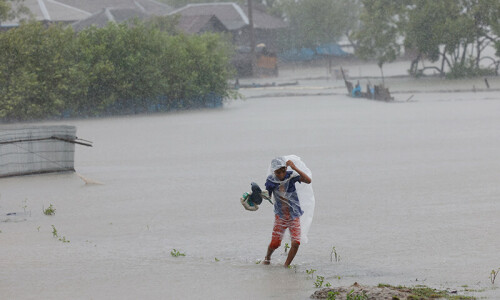
LOS ANGELES: More than a quarter of a million Californians live in coastal areas which could be hit by devastating floods from a major tsunami in the quake-prone US state, a new study says.
The US Geological Survey (USGS) study, published to mark Tsunami Awareness Week, says tidal waves of eight meters or more could hit northern California following a quake of magnitude 8 or more from a well-known tectonic fault line.
“The tragic loss of life and property damage associated with recent catastrophic tsunamis has raised global awareness of tsunami hazards,” the report said, listing the 2004 Indian Ocean and 2011 Japan tsunamis among others.
“Historical and geologic evidence indicate that the California coast has experienced similar large-magnitude tsunamis (and) is susceptible to tsunamis generated by multiple sources,” including quakes far away or nearby.
The 60-page report, issued by the California Emergency Management Agency (EMA), included detailed maps showing the most vulnerable coastline areas, from San Diego in the south to Los Angeles and Oakland, near San Francisco.
Crescent City, 350 miles north of San Francisco near the Oregon border, was among the worst hit places in California from the Japan tsunami, with boats tossed on top of each other in the harbor, and one death.
In all the number of residents in so called “tsunami-inundation” zones is 267,000, while a further 169,000 work in them - and the numbers can swell to several times that at certain times of day, for example on tourist beaches.
Tsunamis generated by an earthquake far away, as in the Japanese case, pose a relatively modest threat both because of the smaller scale of the waves, and the fact there is usually at least several hours' warning.
But a far great danger could come from an earthquake generated on a well-known fault line, the Cascadia Subduction Zone (CSZ), which runs more than 620 miles from northern California to Canada's Vancouver Island, it said.
The CSZ has ruptured and created tsunamis at least seven times in the past 3,500 years, with intervals of anything from 140 years to 1,000 years. The last was in 1700.
“A future CSZ-related earthquake (likely magnitude 8 or larger) would create a series of tsunami waves possibly 8 meters ... or higher that would inundate these communities in 15 to 20 minutes after initial ground shaking,” it said.
“Southern California communities would experience the Cascadia-related tsunamis in a far-field capacity, meaning they would not experience the ground shaking, and waves would arrive approximately one hour later.”













































Dear visitor, the comments section is undergoing an overhaul and will return soon.